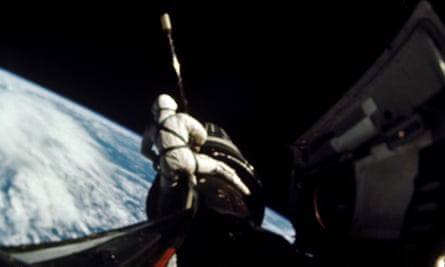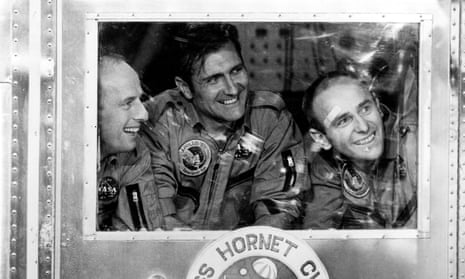Of the 24 astronauts Nasa sent to the moon, only a dozen actually landed there. Richard Gordon, who has died aged 88, was one of the 12 who did not, and in some ways the one whose frustration might have been the highest. Gordon piloted the space module Yankee Clipper on the Apollo 12 mission, orbiting above the moon while his fellow astronauts Pete Conrad and Alan Bean landed the lunar module. He was the backup command pilot for Apollo 17, and was scheduled to command Apollo 18 and finally land on the moon; but that mission was cancelled due to lack of funding, and there have been no further lunar landings.
If Gordon was disappointed at how things turned out, he took it in his stride: “The name of the game, as far as I was concerned, was to walk on the moon ... but I had a job and a function to perform.” Bean described Gordon as “a happy guy” and the “best possible crew mate”, recalling that Gordon made him and Conrad remove their spacesuits covered with moon dust before re-entering the space module. Once, when asked if he had regrets, Gordon quipped “Hell no. If you knew those guys you’d be happy to be left alone.” But the view from 60 miles above the lunar surface inspired him. “It makes you think about the fragility of our Earth, and the things we do to it,” he said.

Gordon was born in Seattle. His father, Richard Sr, was a machinist and logger; his mother, Angela, was a teacher. On graduating from the University of Washington with a degree in chemistry, he joined the US navy, and after his first exposure to planes decided to become a pilot. “Once I found what the airplane could do for me, or I could do for it, it was love at first sight,” he said. He got his wings in 1953 and, after serving as an all-weather pilot, became a test pilot in 1957, and the lead test pilot for the F4H Phantom. In 1961, piloting an F4H-1, he won the Bendix Trophy, racing from Los Angeles to New York in a record 2 hours 47 minutes, setting an air speed record of 869.74mph.
After missing the second intake of astronauts, Gordon joined Nasa in 1963 with the third group, which included Buzz Aldrin, Michael Collins and Gene Cernan. Three years later he piloted the Gemini 11 mission with Conrad, whose aim was to perform the first docking with another spacecraft, the unmanned Agena. They set an altitude record of 850 miles above Earth.
Gordon was so excited about performing his space walk that he was up an hour early, and struggled to get his helmet over his head. Already tired and sweating, he found his visibility restricted by condensation, and some of the docking tasks hampered by lack of handholds and an inability to stabilise himself. “It was like trying to tie a shoelace with one hand,” he explained. He was so exhausted that he actually dozed in space, and it required an immense act of will to propel himself back to the Gemini craft, where Conrad could pull him in. However, on re-entry, Gordon piloted the craft to within two miles of the USS Guam, the pickup ship.

It was another three years before Gordon went to the moon on Apollo 12. The mission was nearly cancelled as the craft was struck twice by lightning during launch, but backup systems allowed the engineers to restore its electrical power. In all, Gordon spent nearly 316 hours in space.
He served in the astronaut office, and helped design the space shuttle, but, with the cancellation of Apollo 18, he left Nasa in 1971, and took a job as executive vice-president and general manager of the New Orleans Saints team in the National Football League; its owner, John Mecom, was a friend. The hapless Saints had joined the league through expansion in 1967, and their struggles continued throughout Gordon’s tenure. He left in 1976 for a series of jobs in engineering, energy and oil companies.
Gordon’s second wife, Linda Saunders, died in September. He is survived by three sons and two daughters from his first marriage, to Barbara Field, which ended in divorce. Another son died in 1982.

Comments (…)
Sign in or create your Guardian account to join the discussion